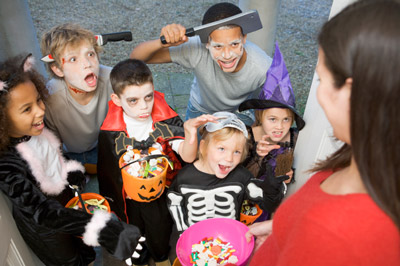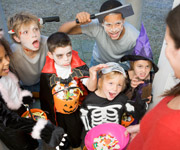 When my brother and I were little, around this time of year we loved to watch The Halloween Tree, an animated feature based on a Ray Bradbury book of the same name. The movie opens with Bradbury himself narrating:
When my brother and I were little, around this time of year we loved to watch The Halloween Tree, an animated feature based on a Ray Bradbury book of the same name. The movie opens with Bradbury himself narrating:
It was a small town by a small river and a small lake in a small northern part of a Midwest state. There wasn’t so much wilderness around that you couldn’t see the town. On the other hand, there wasn’t so much town around that you couldn’t see and feel and touch the wilderness. The town was full of fences to walk on and sidewalks to skate on and the muted cries and laughter of boys and girls full of costume dreams and pumpkin spirits, preparing for the greatest night of the year, better than Easter, better than Christmas — Halloween.
Secure · Tax deductible · Takes 45 SecondsSecure · Tax deductible · Takes 45 Seconds
The basic plot is about a group of kids who follow a crazy-looking dude named Mr. Moundshroud through time to find out the origins of various Halloween traditions (witches in the Dark Ages, werewolves at Notre Dame, Day of the Dead in Mexico, etc.) and rescue their sick friend from death’s greedy clutches. My favorite part has always been the opening scene, before the time travel begins, when the kids race across an idyllic small-town landscape of maple-lined streets, picket fences, and jack-o-lanterns on wraparound porches, challenging each other to candy-collection competitions and shuddering at the thought of certain shadowy shortcuts. The movie captures our cultural conception of Halloween as a children’s holiday at heart, with just enough intrigue to give its innocence an edge.
The movie’s portrayal of this holiday also offers a useful social standard to which we can compare ourselves. Is your town full of fences to walk on, sidewalks to skate on, and the muted cries and laughter of boys and girls? As a kid, the small town in Halloween Tree resembled my version of utopia. I grew up aspiring to live in Norman Rockwell’s America — or at least Beverly Cleary’s — and while my childhood didn’t include neighborhood kick-the-can games or stray dogs adopted on paper routes, I did live in an area at that ideal intersection of density and safety that makes trick-or-treating not only possible but popular.
Few Americans could claim to live in a Rockwellian community anymore — many communities that might have once represented this ideal have been overrun by Walmart, megachurches, or meth. Besides, our concept of what makes a place livable has changed over the years. But as it happens, the factors that make a neighborhood ideal for trick-or-treating — walkability and pedestrian safety, a sense of mutual trust and support among residents — are the same ones usually cited as key ingredients in creating healthy, pleasant places to live.
Just look at two lists of the best cities in which to trick-or-treat: Zillow uses median home value, walk score, population density, and crime to compile its rankings. Richard Florida (cheerleader of the “creative class“) also looks at walkability and density, as well as median household income, the 5-to-14-year-old population, and the fraction of artists and creative people living there. Both lists end up including Boston, San Francisco, Minneapolis, Seattle, and Portland — cities frequently rated as great places to live in general. (I can vouch for Seattle being a great place to trick-or-treat — I’m curious to know whether the other cities live up to their rankings, too.)
Of course, trick-or-treat-ability varies within cities, too. The middle-class block where I grew up usually saw an influx of costumed commuters from less-safe streets nearby.
Kaid Benfield, director of the Natural Resources Defense Council’s sustainable communities program, writes about the “Halloween Test,” a variation on the “Popsicle Test,” which gauges the design of a neighborhood on whether an 8-year-old can go out to buy a popsicle by herself and return home before it melts. If your neighborhood is crawling with fun-size Supermen and Snapes, he reasons, it’s a good sign that it’s healthy and well put together.
Both tests recall influential urban planner Jane Jacobs’ argument that neighborhoods designed to invite pedestrian activity are naturally safer due to the increased number of “eyes on the street.” Sidewalks, accessible amenities, crosswalks, common spaces — the full checklist of a well-designed, mixed-use community — have a function that’s psychological and well as physically practical. When parents feel comfortable letting their kids trick-or-treat or run out for a popsicle, it’s probably because they trust neighbors and local shopkeepers to be casually keeping an eye on things.
I wonder whether the link between Halloween culture and livability has been lost on the leaders of cities around the country that impose various restrictions on trick-or-treating — usually limits on the hours of the day it’s allowed, or the age groups that can participate. Such regulations stem from good intentions to suppress mischief and crime, but maybe they’re missing the point: A neighborhood that goes all out to celebrate Halloween sends the message that residents know and trust each other and are looking out for the common good — and having fun doing it.
Halloween could be for kids what Critical Mass is for bikes and Take Back the Night is for women. It’s a night when kids rule the block again. It’s one reason why, as Ray Bradbury wrote in The Halloween Tree, this holiday is “the greatest night of the year, better than Easter, better than Christmas.” Let’s look for ways to make every day in every neighborhood a little more like Halloween — not by giving out piles of candy, but by giving kids, and free spirits of all ages, free reign of the sidewalks and fences again.



